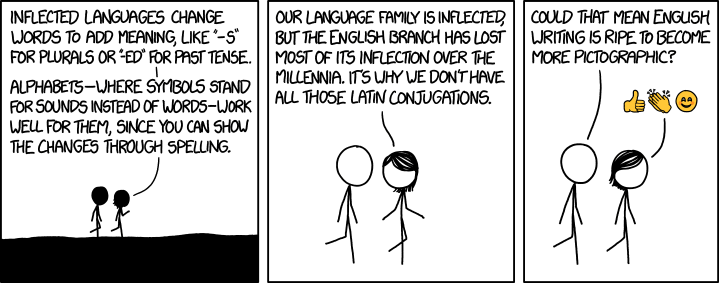Inflection

"Or maybe, because we're suddenly having so many conversations through written text, we'll start relying MORE on altered spelling to indicate meaning!" "Wat."

"Or maybe, because we're suddenly having so many conversations through written text, we'll start relying MORE on altered spelling to indicate meaning!" "Wat."
While walking, Megan tells Cueball that in inflected languages — such as German — changes in the spelling of a word changes its meaning, in a predictable way. Megan exemplifies this with how plural forms of nouns are created by sticking an "s" at the end, and past tense of a verb is done by the suffix "ed". Megan then explains that this works well in languages which build on alphabets.
She continues to explain that their language family belongs to those that are inflected, but the English branch is becoming less inflected than it used to be. Specifically this explains why English does not have so many Latin conjugations. A conjugation is a pattern of inflections, describing how a particular group of verbs is altered from its root form to represent different grammatical cases. Only verbs have conjugations (are conjugated), nouns, pronouns, and adjectives are described by declensions (and are declined). All inflected languages can be described by conjugations and declensions, although Latin is one of the most commonly cited, perhaps because Latin grammar was taught for centuries by monotonous rote learning of the conjugations and declensions.
A typical Latin conjugation would be the verb amare, to love.
Present, Active, Indicative Singular Plural Latin English Latin English 1st person 'amo' I love 'amamus' we love 2nd person 'amas' thou lovest 'amatis' you love 3rd person 'amat' he/she/it loveth 'amant' they love
Perfect, Passive, Subjunctive Singular Plural Latin English Latin English 1st person 'amemor' I should be loved 'amemur' we should be loved 2nd person 'amemaris' thou should be loved 'amemini' you should be loved 3rd person 'ametur' he/she/it should be loved 'amentur' they should be loved (The English singular uses archaic forms to highlight the number and person.) A complete conjugation includes all tenses (Present, Imperfect, Future, Perfect, Pluperfect, and Puture Perfect), both voices (Active & Passive), and all moods (Indicative, Imperative, Subjunctive). Other parts of speech — infinitives, participles, gerunds, and so forth — are needed to completely define the verb, but are not usually considered to be part of the conjugation.
Cueball then asks Could that mean that English writing might be ripe to become more pictographic? Instead of using traditional words, Megan replies with three emojis "Thumbs up" (like), "Applause", and a smiley — thus showing a pictographic version of the writing which has become more popular in the last years. Emoji has become a recurring theme on xkcd.
The writing systems of many languages have both pictographic and ideographic origins. "Pictographic" means that they are pictures of some thing that will remind the reader of either the pronunciation or the meaning of the word. The letter "A", for example, originated from a word meaning "ox", but was meant to remind readers of the glottal stop (it wasn't until the Ancient Greeks, who didn't have the glottal stop as a distinct phoneme, got a hold of the Phoenician version that it was transferred to the vowel(s) it is today). "Ideographic" means that they are designed, through pictures, to illustrate some idea. An example would be a "No Smoking" sign, where a red circle with a diagonal line is an abstract representation of "no". In fact, the three emojis used in the third panel of this cartoon are all ideographic, not pictographic, under this definition. "Thumbs up" (like), "Applause", and the smiley, are all emojis that remind us of a concept of approval.
Egyptian hieroglyphics contain many pictorial elements, some of which are pictographic in the sense that they are meant to represent the thing that they picture, but many are more abstract (ideographic) or are used for their phonetic value (as "A" was used in early alphabetic systems). Similarly, in the Chinese character writing system, many of the elements have pictographic or ideographic origins; but they are often, and even usually combined in ways that are phonetic and not related to the pictures that were the origins of the characters.
Early modern English (think Shakespeare or the KJV Bible) used more forms for the tenses than we do today, which can help illustrate the trend away from inflected forms. In contrast, verbs in English today are often conjugated with auxiliary verbs. See below for details on modern verb conjugation in English.
The title text points out that some intentional misspelling are used in Internet slang to alter the meaning of a word: "what" becomes "wat" to express confusion, disgust or disbelief. The title text also uses typographical variation to emphasize the word MORE by using all capital letters. Such emphasis is difficult to show with inflected language alone.
This comic is referenced at 4500 BCE in huge chart of 1732: Earth Temperature Timeline. According to that comic it was at that time inflection was invented but just to tease future students so they have to remember a zillion verb endings.